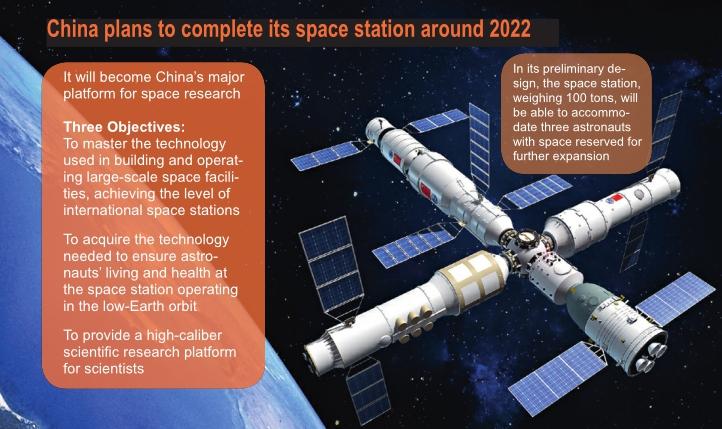Keeping Outer Space Peaceful and Safe
By THOMAS S.AXWORTHY

SPACE has become more and more woven into our daily lives: Satellites that orbit the earth send and receive signals and data that are used for Internet communication. Satellites also produce the GPS networks that allow us to navigate our streets, pinpoint our locations, and monitor our weather. Meanwhile the introduction of 5G capability will substantially increase the speed of the Internet and“the Internet of things” propelled by artificial intelligence and the rise of big data.
Over 80 countries own or operate more than 3,000 active satellites now orbiting in space and today almost every person on the globe is a user of space data/ services from the cell phone user in remote parts of Africa, to massive institutions in the U.S. like the Microsoft system cloud storage. While our image of space is usually state centric with space missions organized by the National Aeronautics and Space Administration(NASA) of the U.S. or the Chinese National Space Administration, the private sector is increasing its impact in space exponentially: In the past year, SpaceX, owned by entrepreneur Elon Musk, has launched more than 1,000 satellites. According to Victoria Samson, Washington Office Director of Secure World Foundation, in a February 2021 article “Threats to Space Arent Just Weapons” published by TRENDS Research & Advisory that succinctly outlines the issues involved in the current debate over outer space and informs much of this commentary, there is high probability that the number of satellites will reach more than 100,000 by 2029, vastly affecting space traffic considerations, competition over the spectrum, and the problem of space debris.
The 1967 Outer Space Treaty establishes that all nations should have free access to space and that exploration of the cosmos should be a peaceful enterprise “for the benefit and in the interests of all countries.” Space and celestial bodies cannot be appropriated by a state, i.e., no country can claim the moon. The treaty prohibits countries from putting nuclear weapons in orbit and tasks countries with “avoiding the harmful contamination of celestial bodies.” The treaty represents the best ideals of humankind privileging planetary protection, the common good, and peaceful cooperation.
These ideals have largely been put into practice. Nations share space tracking stations: China, for example, has tracking stations in Kenya and Argentina and shares other facilities jointly with France, Brazil, Sweden, and Australia. The International Space Station is a multinational collaborative modular space station in low Earth orbit involving the U..S., Russia, Japan, Europe, and Canada. In November 2019, after many years of work, the United Nations approved a draft resolution on cooperation in the peaceful use of outer space with specific guidelines for the “Long-term Sustainability of Outer Space Activities.” Chinas representative emphasized that there should be no legal or regulatory vacuum in the governance of space resources exploration and pressed for the creation of a working group within the Legal Subcommittee of the Committee on the Peaceful Uses of Outer Space (COPUOS) to develop international rules and regulations. With 100,000 satellites on the horizon, greatly pushed by the private sector, the need for a global framework is obvious. In the 19th century, transformative changes in communication technology, such as the telegraph and underwater cables, led to some of the first international organizations like the International Telegraph Union formed in 1865 and the Universal Postal Union established in 1874, and in the 21st century, we will need the same creativity to govern communication satellites in space.
But, alas, as is common with humankind, for every bit of news that gives one hope there are just as many actions that bring despair. In November 2020, to complement the 2019 work of the UN Fourth Committee on peaceful cooperation in space, the UN First Committee on Disarmament and International Security passed four resolutions on “confidence building measures in outer space,” “no first placement of weapons in outer space,”“prevention of an arms race in outer space,” and “reducing space threats through norms, rules and principles of responsible behavior.” These hopeful declarations, however, followed state behavior that increased the militarization of outer space instead of reducing it. In 2019, former U.S. President Donald Trump announced the creation of the U.S. Space Force, the sixth branch of the U.S. military, saying that his “new national strategy for space recognizes that space is a war-fighting domain just like the land, sea and air,” the exact opposite of the intent of the UN declarations on outer space. The U..S. was not alone in violating the spirit of a peaceful outer space. In 2019, India launched an anti-satellite missile in Low Earth Orbit, becoming the fourth country to test an anti-satellite (ASAT) weapon. Earlier in 2020, Russia conducted a space-based test with something similar to a “space torpedo,” launched from a satellite to destroy another satellite. What we see happening is that nations are falling into their long-standing behavior of trying to gain an advantage over potential opponents through military means. Satellites are as crucial for national security as they are for national prosperity in our Internet age and old competitive impulses will not go away.
The 1967 outer space treaty bans nuclear weapons in outer space, but not other forms of military activity like spy satellites or conventional weapons like anti-satellite missiles. The Treaty commits states to advance “peace- ful purposes” but the U.S. and other space powers have interpreted this as allowing national security activities in space, such as satellites used for intelligence gathering, navigation, targeting, and early warning of missile attacks. But such space assets are easily targeted and therefore states have been developing counterspace capacity in a new celestial arms race.
There have been many attempts to prevent the militarization of space. In 1985, the UN Conference on Disarmament established an ad hoc committee on the Prevention of an Arms Race in Outer Space(PAROS), but the U.S. refused to negotiate. The European Union has developed an“International Code of Conduct for Outer Space Activities.” Perhaps the most encouraging initiative was from China and Russia, which proposed in 2008, and then again in 2014, a draft Treaty on the Prevention of Placement of Weapons in Outer Space. This was aimed at space based antimissile technology. The U.S. opposed this initiative citing concerns about verification, but never proposed its own treaty or entered into negotiations.
The Sino-Russian initiative is a good building block on which to start a new push to end the arms race in space. In addition to its prohibitions on space-based technology, there should be a banning of ground based anti-satellite tests and deployments. Or a protocol could be added to the existing Outer Space Treaty banning all types of weapons deployment in space, not just weapons of mass destruction.
After the passage of the outer space resolutions in December 2020, states were invited to send ideas and implementation plans to the UN Secretary-General who will issue a report this year. Here China could play a key role: In 2003 it was the third country to send humans into space. In 2020 it successfully tested a reusable experimental spacecraft. China plans to build an international space station by 2022 and Chinese officials have spoken about future missions to the Moon and even to Mars. China is a new space power, and it could lead the way in ensuring that the old ways of action-reaction arms races do not spoil the heavens as they have so disfigured the earth.

